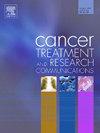Trop-2 expression as a biomarker of response to sacituzumab govitecan in patients with HER2-negative metastatic breast cancer: A pilot study
IF 2.4
Q3 Medicine
引用次数: 0
Abstract
Background
Sacituzumab govitecan (SG) is an anti-Trop-2 antibody-drug conjugate (ADC) approved for use in HER2-negative metastatic breast cancer (MBC). This study explores whether Trop-2 expression serves as a biomarker of excellent response versus non-response to sacituzumab govitecan (SG) in HER2-negative MBC.
Methods
Trop-2 expression was determined from patients with HER2-negative MBC categorized as non-responders and excellent responders to SG. Excellent response was defined by a complete or partial response and a progression-free survival (PFS) greater than the median of the cohort. Non-response was defined by progressive disease within 3 months. Trop-2 expression was determined based on percentage of cells staining and a histochemical score (H-score).
Results
Of the 15 patients with HER2-negative MBC (8 non-responders/7 excellent responders), the median Trop-2 expression rate was 100 % in both groups (p=0.3). H-score was also similar between the groups, with a median H-score of 270 (range 25–300) in non-responders and 280 (range 120–290) in responders (p=1.0). Lower Trop-2 percent expression was associated with shorter PFS (hazard ratio [HR]: 0.014; 95 % CI, 0–0.52; p=0.018), although Trop-2 expression by H-score was not predictive of PFS (HR: 0.994; 95 % CI, 0.987–1.002; p=0.12). One non-responder had an H-score of 25, which may represent a complete lack of Trop-2 expression.
Discussion
In this study, Trop-2 expression did not predict excellent response versus non-response to SG in patients with HER2-negative MBC. Low Trop-2 expression, as determined by percentage staining, was predictive of shorter PFS, although the same association was not observed using the H-score. A complete lack of Trop-2 expression may predict SG ineffective, which requires further investigation.
Trop-2表达作为her2阴性转移性乳腺癌患者对sacituzumab govitecan反应的生物标志物:一项初步研究
背景:sacituzumab govitecan (SG)是一种抗trop -2抗体-药物偶联物(ADC),被批准用于her2阴性转移性乳腺癌(MBC)。本研究探讨了Trop-2表达是否作为her2阴性MBC患者对sacituzumab govitecan (SG)的良好反应与无反应的生物标志物。方法测定her2阴性MBC患者对SG无反应和极好反应的strop -2表达。优秀的应答被定义为完全或部分应答,且无进展生存期(PFS)大于队列的中位数。无反应的定义是疾病在3个月内进展。根据细胞染色百分比和组织化学评分(H-score)来测定Trop-2的表达。结果15例her2阴性MBC患者(无应答者8例/极应答者7例),两组中位Trop-2表达率均为100% (p=0.3)。H-score在两组之间也相似,无应答者的中位H-score为270(范围25-300),应答者的中位H-score为280(范围120-290)(p=1.0)。较低的trop - 2%表达与较短的PFS相关(风险比[HR]: 0.014;95% ci, 0-0.52;p=0.018),但通过h评分表达Trop-2并不能预测PFS (HR: 0.994;95% ci, 0.987-1.002;p = 0.12)。一个无应答者的h值为25,这可能代表完全缺乏Trop-2的表达。在这项研究中,Trop-2的表达并不能预测her2阴性MBC患者对SG的良好反应和无反应。通过百分比染色确定的低Trop-2表达可预测较短的PFS,尽管使用h评分未观察到相同的关联。完全缺乏Trop-2表达可能预示SG无效,有待进一步研究。
本文章由计算机程序翻译,如有差异,请以英文原文为准。
求助全文
约1分钟内获得全文
求助全文
来源期刊

Cancer treatment and research communications
Medicine-Oncology
CiteScore
4.30
自引率
0.00%
发文量
148
审稿时长
56 days
期刊介绍:
Cancer Treatment and Research Communications is an international peer-reviewed publication dedicated to providing comprehensive basic, translational, and clinical oncology research. The journal is devoted to articles on detection, diagnosis, prevention, policy, and treatment of cancer and provides a global forum for the nurturing and development of future generations of oncology scientists. Cancer Treatment and Research Communications publishes comprehensive reviews and original studies describing various aspects of basic through clinical research of all tumor types. The journal also accepts clinical studies in oncology, with an emphasis on prospective early phase clinical trials. Specific areas of interest include basic, translational, and clinical research and mechanistic approaches; cancer biology; molecular carcinogenesis; genetics and genomics; stem cell and developmental biology; immunology; molecular and cellular oncology; systems biology; drug sensitivity and resistance; gene and antisense therapy; pathology, markers, and prognostic indicators; chemoprevention strategies; multimodality therapy; cancer policy; and integration of various approaches. Our mission is to be the premier source of relevant information through promoting excellence in research and facilitating the timely translation of that science to health care and clinical practice.
 求助内容:
求助内容: 应助结果提醒方式:
应助结果提醒方式:


